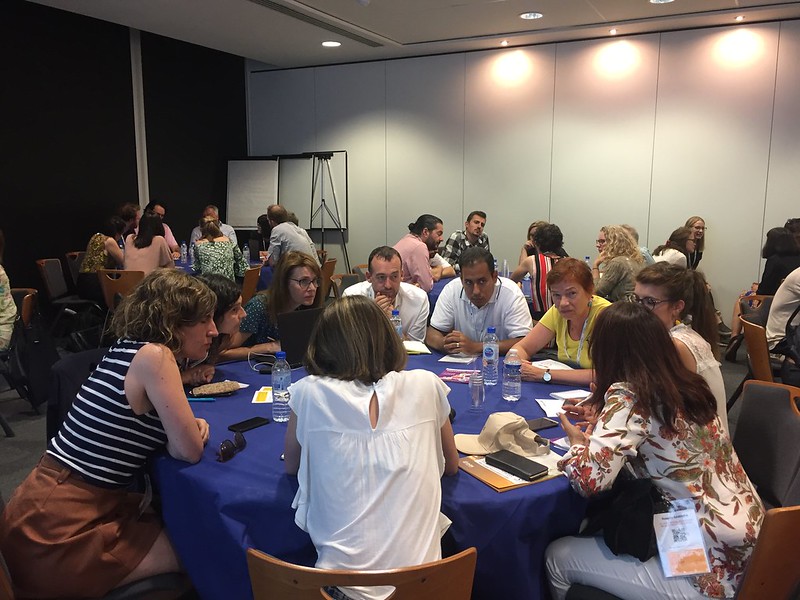When research and scientific methods are increasingly being questioned, science communication needs to become keener. Evidence-based science communication is one way of doing this.

Science communication becomes ever more important to maintain an open and democratic society, not least when people in power and politicians tend to ignore scientific evidence. This was the starting point for the seminar “Scicomm researchers and science communicators bridging the divide”, initiated by Sweden and held at the major research conference ESOF in Toulouse on 9–14 July.
How shall science communicators and the scicomm researchers approach each other? And can we in this way achieve greater impact for evidence-based facts in society?
– We don’t necessarily need more science communication, but we do need better science communication. And in order to improve it, it needs to become more evidence-based, says Anna Maria Fleetwood, who works with the Swedish Research Council’s mandate to coordinate science communication in Sweden, and who was one of the speakers.
The seminar was full up and also one of the liveliest at ESOF. The concept of evidence-based science communication aroused some feeling among the practitioners in the hall.
– The problem is that scicomm research is invisible, said one of the participants. And the research carried out is rarely of relevance to our work.
So what is science communication, and why does it have to be evidence-based?
– The time when scicomm meant one-way communication and disseminating research findings is long past. What is happening today is something quite different from sending out press releases or producing reports, says Anna Maria Fleetwood.
– Today, science communication is just as much about reaching out with evidence to politician and decision-makers. And it is not always the researchers themselves that provide the accessibility, even though they of course need to be involved.
Another important part of today’s science communication is what we call science literacy, or the necessity to understand how science works, and how the scientific method differs from personal opinion, such as not believing in climate change, for example.
But as yet, evidence-based science communication is not a matter of course, and the divide exists – between science communicators and scicomm researchers.
– Science communicators are not aware of the research that exists within the area. At the same time, researchers are ignoring the actual questions that exist within practical science communication. A mutual lack of knowledge, said for example Alexander Gerber, Professor of Science Communication at the Rhein Waal University in Germany.
The craft, of creating a press release, an article or a magazine for example, is still important, but is only one part of all the knowledge required. Knowledge of empirical data from sociology studies of how people adopt information, how political decisions are made and how certain social media platforms influence dissemination is equally important. We need science communication where, for example, we use results from empirical sociology studies to design strategies for how we should communicate.
– We should therefore think about how we educate today’s science communicators, says Alexander Gerber, who is coordinating the only three-year programme within science communication in Europe.
The divide between researchers and communicators
Aleksandra Drecun, President of Intersection, who works on integrating research and society in the Balkans, was able to give another perspective on the prerequisites for science communication.
– Science communication receives very few resources. And the majority of science communicators were trained within PR and need to develop their methods.
– The real problem here is not the divide between science communicators and scicomm researchers. The biggest problems is that there are so very few of them, and quite simply no basis for a divide.
– What we do is to highlight the fundamental arguments for why science communication is so important for society, in dialogue with decision-makers, research funding bodies and researchers. Unfortunately, the largest divide here is between researchers and communicators. Not because researchers think it is unimportant, but because every communication effort takes resources away from the research itself, which is already carried out on a very tight budget, says Aleksandra Drecun.
– The best science communication is deeply anchored in research, when the communicators learn from the research into science communication. Conversely, the best scicomm research is that which learns from the practitioners, but also itself carries out science communication, says Dr Melanie Smallman, who does research in science communication at University College, London.
– A biologist would never enter a laboratory without respecting the underlying knowledge within the area. So why shouldn’t a science communicator partake of the knowledge that underlies science communication?
The question is also how easy it is to partake of scicomm research, and to apply it in the daily work?
The purpose of the session at ESOF was to arrive at a joint set of concrete proposals for measures to bridge the divide between scicomm researchers and science communicators. Following lively round-table discussions and synthetisation of the proposals that emerged, all participants voted for the proposals they considered best. The results were:
- Practitioners and scientists shall work side-by-side
- An evidence-based toolbox with best-practice methods for science communicators
- Evidence-based training for science communicators
- Meeting places where researchers and communicators can exchange experiences and perspectives
- Communication training for scicomm researchers
- Make research in science communication more accessible
- Increased mutual respect
- Learn from similar discussions in other fields, such as teachers and research into educational sciences
The session was arranged by the Swedish Research Council, VA (Public & Science), whose Secretary General Cissi Askwall acted as moderator, and the University of Trento, Italy.
Fact: ESOF, EuroScience Open Forum, attracted 4 600 participants from 83 countries. The seminar “Scicomm researchers and science communicators bridging the divide” was full up.
Text: Carina Olsson, Swedish Research Council
Photo: Cissi Askwall, VA (Public & Science)
